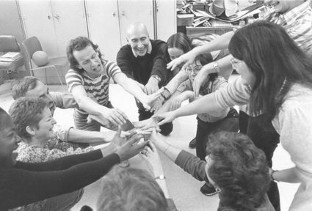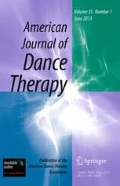


References
Acharya, S., & Shukla, S. (2012). Mirror neurons: Enigma of the metaphysical modular brain. Journal of Natural Science, Biology, and Medicine, 3(2), 118–124. https://doi.org/10.4103/0976-9668.101878.
American Dance Therapy Association (Producer). (2013). ADTA Talks: Dance/Movement Therapy: Psychodiagnosis, Movement, and Neurology, Robyn Flaum Cruz. Retrieved from https://www.youtube.com/watch?v=mu67F5OjwME
Bearrs, K. A., McDonald, K. C., Bar, R. J., & DeSouza, J. F. X. (2017). Improvements in balance and gait speed after a 12 week dance intervention for Parkinson’s disease. Advances in Integrative Medicine, 4, 10–13.
Berrol, C. (2016). Reflections on dance/movement therapy and interpersonal neurobiology: The first 50 years. American Journal of Dance Therapy, 38(2), 303–310.
Bothwell, L. E., & Podolsky, S. H. (2016). The emergence of the randomized controlled trial. New England Journal of Medicine, 375(6), 501–504.
Chaiklin, H. (1975). Marian Chace: Her papers. Columbia, MD: American Dance Therapy Association.
Chaiklin, H., & Chaiklin, S. (2012). The case study. In R. F. Cruz & C. F. Berrol (Eds.), Dance/movement therapists in action: A working guide to research options (2nd ed., pp. 75–101). Springfield, IL: Charles C. Thomas.
Cruz, R. F. (1995). An empirical investigation of the Movement Psychodiagnostic Inventory. Dissertation Abstracts International: Section B: The Sciences & Engineering Vol. 57(2-B), August, 1996, 1495.
Cruz, R. F. (2016). Dance/movement therapy and developments in empirical research: The first 50 years. American Journal of Dance Therapy, 38(2), 297–302.
Davis, M. (1991). Guide to movement analysis methods part 2: Movement psychodiagnostic inventory.
Depez, E. E., & Chen, C. (2017). Medical journals have a fake news problem. Retrieved from https://www.bloomberg.com/news/features/2017-08-29/medical-journals-have-a-fake-news-problem
Devereaux, C. (2017). Educator perceptions of the inclusion of dance/movement therapy within the special education classroom. Body, Movement, and Dance in Psychotherapy, 12(1), 50–65. https://doi.org/10.1080/17432979.2016.1238011.
Dominus, S. (2017). When the revolution came for Amy Cuddy. New York Times Magazine, pp. 28–33, 50–55.
Hanna, J. L. (2014). Dancing to learn: The brain’s cognition, emotion, and movement. London: Rowman & Littlefield.
Hulbert, S., Ashburn, A., Roberts, L., & Verheyden, G. (2017). Dance for Parkinson’s—the effects on whole body co-ordination during turning around. Complementary Therapies in Medicine, 32, 91–97.
Kattensroth, J. C., Kalisch, T., Holt, S., Tegenthoff, M., & Dinse, H. R. (2013). Six months of dance intervention enhances postural, sensorimotor, and cognitive performance in elderly without affecting cario-respiratory functions. Frontiers in Aging Neuroscience. https://doi.org/10.3389/fnagi.2013.00005.
Kawano, T. (2017). Developing a dance/movement therapy approach to qualitatively analyzing interview data. The Arts in Psychotherapy, 56, 61–73.
Ko, K. S. (2016). East Asian students’ experiences of learning dance/movement therapy in the US: A phenomenological investigation. American Journal of Dance Therapy, 38(2), 358–377.
Mau, L. W., & Giordano-Adams, A. (2016). Social media and dance/movement therapy: The first 50 years. American Journal of Dance Therapy, 38(2), 378–406.
McNeely, M. E., Duncan, R. P., & Earhart, G. M. (2015). Impacts of dance on non-motor symptoms, participation, and quality of life in Parkinson disease and healthy older adults. Maturitas, 82, 336–341.
Mollett, A., Brumley, C., Gilson, C., & Williams, S. (2017). Communicating your research with social media. London: Sage.
National Institutes of Health. (2016). A short history of the National Institutes of Health by Victoria A. Harden. Retrieved from https://history.nih.gov/exhibits/history/index.html
Olvera, A. E. (2008). Cultural dance and health: A review of the literature. American Journal of Health Education, 39(6), 353–359. https://doi.org/10.1080/19325037.2008.10599062.
Stahl, J. (2017). We are born to love dance—science says so! Dance Magazine. Retrieved from http://www.dancemagazine.com/why-humans-love-dance-2487518208.html
Sur, R. L., & Dahm, P. (2011). History of evidence-based medicine. Indian Journal of Urology, 27(4), 487–489. https://doi.org/10.4103/0970-1591.91438.
Tantia, J. F. (2014). Body-focused interviewing: Corporeal experience in phenomenological inquiry, In SAGE Research Methods Cases. London: SAGE Publications Ltd. http://dx.doi.org/10.4135/978144627305013519226
Thaut, M. H., & Abiru, M. (2010). Rhythmic auditory stimulation in rehabilitation of movement disorders: A review of current research. Music Perception, 27(4), 263–269.
Timothy, E. K., Graham, F. P., & Levack, W. M. M. (2016). Transitions in the embodied experience after stroke: Grounded theory study. Physical Therapy, 96(10), 1565–1575.
Wingfield, B. (2017). The peer review system has flaws but it’s still a barrier to bad science. The Conversation. Retrieved from https://theconversation.com/the-peer-review-system-has-flaws-but-its-still-a-barrier-to-bad-science-84223
Young, J. (2017). The therapeutic movement relationship in dance/movement therapy: A phenomenological study. American Journal of Dance Therapy, 39(1), 93–112.
Author information
Authors and Affiliations
Corresponding author
Ethics declarations
Conflict of interest
The author declares that she has no conflict of interest.
Research Involved in Human and Animal Rights
This article does not contain any studies with human participants or animals performed by any of the author.
Rights and permissions
About this article
Cite this article
Cruz, R.F. Marian Chace Foundation Lecture: Rhythms of Research and Dance/Movement Therapy. Am J Dance Ther 40, 142–154 (2018). https://doi.org/10.1007/s10465-018-9267-7
Published:
Issue Date:
DOI: https://doi.org/10.1007/s10465-018-9267-7

